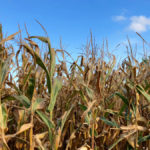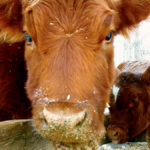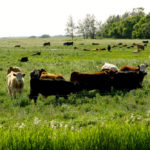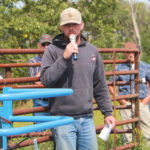
Tag Archives cattle feeding

Warm season crops and cool climates
Research on the Record with Reynold Bergen
According to Statistics Canada, silage corn acreage was 26 per cent higher in 2015-19 than in 2010-14. Most of this increase occurred in the Prairies. Achieving corn’s potential will depend on whether plant breeders can successfully adapt this warm-season plant to Canada’s cooler climate. Plants contain two kinds of carbohydrates. Non-structural carbohydrates are starches and […] Read more

Math 101 for beef producers
Nutrition with John McKinnon
When I discuss various aspects of nutrition with producers, I often sense confusion when it comes to “as fed” versus “dry matter” (DM) conversions. Such conversions have a profound effect on our ability to predict feed intake and on our understanding of ration nutrient concentration, feed costs and on cost of gain calculations. If one […] Read more

A new decade – same production issues
Nutrition with John McKinnon
As I write this article, we have just entered a new year and indeed a new decade. While we do not know what the next 10 years will hold for us, we do know that many of the production issues we faced in the last decade will still be with us as we move into […] Read more

How well do you mix your cattle feed?
Nutrition with John McKinnon
When it comes to putting quality feed in front of cattle, there are about as many ways to accomplish this task as there are cattle operations. In most finishing operations, we see total mixed rations (TMR) delivered via mixer wagons, while in cow-calf operations we see everything from pail-feeding grain and ad libitum bale feeding […] Read more

Feed bunk management key to a sound feeding program
Nutrition with John McKinnon
In my last two columns, we have looked at issues with starting cattle on feed, as well as providing insight into the design of backgrounding and finishing programs. In this column, the focus will be on management of the feeding program, particularly feed bunk management. At its most basic level, feed bunk management is the […] Read more

Cattle researchers map feed-efficiency genes
Research: News Roundup from the November 2019 issue of Canadian Cattlemen
After sifting through thousands of genes, researchers have flagged a handful of genes that seem to be related to feed efficiency in cattle. Hui-Zeng Sun, a post-doctoral student at the University of Alberta, used functional genomics and computational statistics to better understand feed efficiency, writes Justin Dupuis on the U of A’s research blog, folio. […] Read more

Research suggests trace mineral source matters
New research shows that organic trace mineral supplementation has benefits over its inorganic counterparts
When it comes to mineral supplementation for beef females, new research suggests that the source matters. Studies from the University of Florida show that organic trace mineral supplementation for cows has benefits compared to inorganic trace minerals in areas such as increased pregnancy rates, weaning weight and calf immunity. Dr. Matt Hersom is an associate […] Read more

Some thoughts on cattle feeding program design
Nutrition with John McKinnon
In my last column, I discussed some of the issues cattle feeders — particularly those new to feeding — face when starting calves on feed. The basic message was that with feed intake, these animals need to get off to a fast start to minimize issues associated with weaning stress and the various disease challenges […] Read more

Saskatchewan producers reap benefits of silage crops
After a dry year, these Hanley-area producers are banking on silage to help winter the herd
Moisture levels through spring and summer were plentiful in some areas of Western Canada, but in south-central Saskatchewan, Mother Nature was stingy with the rain when it was needed the most. That put even more emphasis on potential yields and benefits of silage crops for two Hanley-area operations. Perry Dyck is owner and president of […] Read more

Study shows cattle temperament affects feedlot performance
Calmer animals perform better in the feedlot and have higher carcass quality and value than their more excitable counterparts
Differences in beef cattle temperament could significantly affect value from the feedlot to the plate, according to a Texas A&M University study. These findings, published in the Journal of Animal Science, show that heifers with calmer temperaments have better feedlot performance and, as a result, higher carcass quality and value than those with more excitable […] Read more



